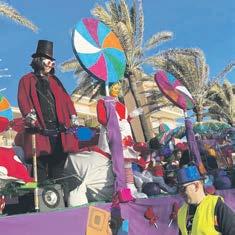
2 minute read
LA CULTURA FULL GLORY!
Street Parties and colourful costumes flood the streets
IT’S back in its full glory!
Advertisement
2023 welcomed the return of the Sa Rua carnival for the first time without restrictions since the pandemic.
This year’s festivities were set to be extremely popular and they did not disappoint. Carnivals took place across the island with various municipalities dishing out a range of prizes and awards with the biggest one taking place in Palma. The carnival is celebrated as a precursor to Semana Santa and Lent and sees the streets be-
Op Quick Crossword
By Nadia McDonald
come awash with dazzling costumes, twirling dancers and parades of people.
In 2020 the Palma City Hall decided to introduce a separate day to the festivities in the week preceding Sa Rua - Sa Rueta, a similarly joyous affair, is aimed at families and children.

This year saw the second ever instalment of Sa Rueta with families flocking to the streets between 11am and 2pm to make the most of the 31 activities and installations on Children enjoyed climbing walls, circuses, animated characters, theatres, popular games, face painting, musical entertainment, clowns and storytellers.
Then Sunday saw the Sa Rua carnival take place at 5pm and play host to thousands of participants including numerous floats and dance troupes. Four prizes were awarded for the most imaginative floats with another four for dance troupes; the categories included most original, demanding, elaborate and liveliest.
The prizes were €450 and €200 respectively and aimed to particularly recognise those that encapsulated the ‘ironic and satirical nature of the carnival’.
Key elements to every Mallorquin and Catalan carnival are the distinctive papier-mâché ‘Giants’ and ‘Big heads’ (Gegants i Capgrossos), a tradition that has a long and twisted history. According to the Catalan Costumari the first known presence of these processional giants were biblical depictions dating back to 1380 in Barcelona. In Mallorca the first reference to a pair of Giants is thought to have been in 1630.
Banned
2
3
The participation of festival giants in religious ceremonies was banned by Charles III in 1780, considering them grotesque and too far removed from their religious characters. Records suggest the religious giants owned by Palma City Council were then guarded in a church.
As time went on the giants began to depict popular figures such as council members, city founders and key players in the region’s history.
17
18 Type of grace, perhaps? (7)
21 Car he adapted to sail across the wind (5)
22 Single things (5)
25 Additional (4)
All solutions are on page 14
During the Franco regime the Gegants and Capgrossos practically disappeared, the representation of popular heroes was seen as a ‘pagan’ practice and to avoid enraging the regime, the giants adopted the characters of the Catholic Kings.
With the arrival of democracy, the processional giants readopted their local identities, marking a new era for the Gegants and a guaranteed survival of this tradition.




